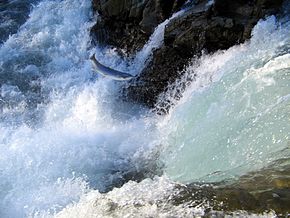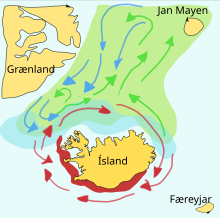Fish migration

Fish migration is mass relocation by fish from one area or body of water to another. Many types of fish migrate on a regular basis, on time scales ranging from daily to annually or longer, and over distances ranging from a few metres to thousands of kilometres. Such migrations are usually done for better feeding or to reproduce, but in other cases the reasons are unclear.
Fish migrations involve movements of
Marine
Salmon and striped bass are well-known anadromous fish, and freshwater eels are catadromous fish that make large migrations. The bull shark is a euryhaline species that moves at will from fresh to salt water, and many marine fish make a diel vertical migration, rising to the surface to feed at night and sinking to lower layers of the ocean by day. Some fish such as tuna move to the north and south at different times of year following temperature gradients. The patterns of migration are of great interest to the fishing industry. Movements of fish in fresh water also occur; often the fish swim upriver to spawn, and these traditional movements are increasingly being disrupted by the building of dams.[3]
Classification

As with various other aspects of fish life, zoologists have developed empirical classifications for fish migrations.[5] The first two following terms have been in long-standing wide usage while others are of more recent coinage.
- Anadromous – fish that migrate from the sea up (Greek: ἀνά aná, "up" and δρόμος drómos, "course") into fresh water to spawn, such as salmon, striped bass,[6] and the sea lamprey[7]
- Catadromous – fish that migrate from fresh water down (Greek: κατά kata, "down" and δρόμος dromos, "course") into the sea to spawn, such as eels[6][8]
George S. Myers coined the following terms in a 1949 journal article.
- Diadromous – all fish that migrate between the sea and fresh water. Like the two aforementioned, well-known terms, diadromous was formed from Classical Greek([dia], "through"; and [dromous], "running").
- Amphidromous – fish that migrate from fresh water to the sea, or vice versa, but not for the purpose of breeding. Instead they enter saltwater or freshwater as larvae, where they will grow into juveniles before returning to the habitat they originally came from and stay there for the rest of their life, growing into sexually mature adults.[9]
- Potamodromous – fish whose migrations occur wholly within fresh water
- Oceanodromous – fish that live and migrate wholly in the sea[5][10]
Although these classifications were originated for fish, they are, in principle, applicable to any aquatic organism.
List of diadromous orders and families, and the number of known species:[9][11]
Forage fish

Forage fish often make great migrations between their spawning, feeding and nursery grounds. Schools of a particular stock usually travel in a triangle between these grounds. For example, one stock of herrings have their spawning ground in southern Norway, their feeding ground in Iceland and their nursery ground in northern Norway. Wide triangular journeys such as these may be important because forage fish, when feeding, cannot distinguish their own offspring.[3]
Capelin are a forage fish of the smelt family found in the Atlantic and Arctic oceans. In summer, they graze on dense swarms of plankton at the edge of the ice shelf. Larger capelin also eat krill and other crustaceans. The capelin move inshore in large schools to spawn and migrate in spring and summer to feed in plankton rich areas between Iceland, Greenland and Jan Mayen. The migration is affected by ocean currents. Around Iceland maturing capelin make large northward feeding migrations in spring and summer. The return migration takes place in September to November. The spawning migration starts north of Iceland in December or January.[12]
The diagram on the right shows the main
In a paper published in 2009, researchers from Iceland recount their application of an interacting particle model to the capelin stock around Iceland, successfully predicting the spawning migration route for 2008.[13]
Highly migratory species
The term highly migratory species (HMS) has its origins in Article 64 of the
.These high
Highly migratory species can be compared with
It can be challenging to determine the population structure of highly migratory species using physical tagging. Traditional genetic markers such as short-range PCR products, microsatellites and SNP-arrays have struggled to identify population structure and distinguish fish stocks from separate ocean basins. However, population genomic research using RAD sequencing in yellowfin tuna,[17][18] albacore,[19][20] and wahoo[21] has been able to distinguish populations from different ocean basins and reveal fine-scale population structure. Similar population genomics methods have also provided improved insight towards population structure in striped marlin.[22]
Other examples
Some of the best-known anadromous fishes are the
Several

An example of a euryhaline species is the bull shark, which lives in Lake Nicaragua of Central America and the Zambezi River of Africa. Both these habitats are fresh water, yet bull sharks will also migrate to and from the ocean. Specifically, Lake Nicaragua bull sharks migrate to the Atlantic Ocean and Zambezi bull sharks migrate to the Indian Ocean.
Diel vertical migration is a common behavior; many marine species move to the surface at night to feed, then return to the depths during daytime.
A number of large marine fishes, such as the tuna, migrate north and south annually, following temperature variations in the ocean. These are of great importance to fisheries.
Freshwater (potamodromous) fish migrations are usually shorter, typically from lake to stream or vice versa, for spawning purposes. However, potamodromous migrations of the endangered Colorado
Sometimes fish can be dispersed by birds that eat fish eggs. They carry eggs in the digestive tracts and then deposit them in their faeces in a new place. The survival rate for fish eggs that have passed through a bird's digestive tract is low.[24]
Historic exploitation
Since
Myxovirus genes
Because
See also
- Animal navigation – Ability of many animals to find their way accurately without maps or instruments
- Hydrological transport model
- Semelparity and iteroparity – Classes of possible reproductive strategies
- Ocean Tracking Network
- Pacific Ocean Shelf Tracking Project – Field project of the Census of Marine Life
- Tagging of Pacific Predators – Field project by Census of Marine Life
- The Blue Planet – 2001 British nature documentary television series
Notes
- doi:10.1641/B570206
- S2CID 241447.
- ^ ISBN 978-1-78639-398-2.
- ^ Atlantic Salmon Life Cycle Archived January 15, 2014, at the Wayback Machine Connecticut River Coordinator's Office, U.S. Fish and Wildlife Service.
- ^ a b Secor, David H; Kerr L A (2009). "Lexicon of life cycle diversity in diadromous and other fishes". Am. Fish. Soc. Symp. (69): 537–556.
- ^ OCLC 52386194.
- ^ a b Silva, S., Araújo, M. J., Bao, M., Mucientes, G., & Cobo, F. (2014). "The haematophagous feeding stage of anadromous populations of sea lamprey Petromyzon marinus: low host selectivity and wide range of habitats". Hydrobiologia, 734(1), 187–199.
- ^ OCLC 1032266421.
- ^ a b Investigating Diadromy in Fishes and Its Loss in an -Omics Era
- JSTOR 1438482.
- ^ Supplemental Information
- .
- ^ Barbaro1 A, Einarsson B, Birnir1 B, Sigurðsson S, Valdimarsson S, Pálsson ÓK, Sveinbjörnsson S and Sigurðsson P (2009) "Modelling and simulations of the migration of pelagic fish" Journal of Marine Science, 66(5):826-838.
- Law of the Sea: Text
- Pacific Fishery Management Council: Background: Highly Migratory Species
- FAO (2007) Report of the FAO workshop on vulnerable ecosystems and destructive fishing in deep sea fisheries, Rome, Fisheries Report No. 829. HTML
- PMID 26593698.
- PMID 30224658.
- PMID 31624554.
- PMID 34025772.
- S2CID 236381627.
- PMID 32211060.
- OCLC 212130719.
- ^ "Experiment shows it is possible for fish to migrate via ingestion by birds". phys.org. Retrieved 2020-06-23.
- ^ C.M. Hogan, 2008
- S2CID 147706565.
References
- Blumm, M (2002) Sacrificing the Salmon: A Legal and Policy History of the Decline of Columbia Basin Salmon Bookworld Publications.
- Bond, C E (1996) Biology of Fishes, 2nd ed. Saunders, pp. 599–605.
- Hogan, C M (2008) Morro Creek, The Megalithic Portal, ed. by A. Burnham
- Appendix A: Migratory Fish Species in North America, Europe, Asia and Africa in Carolsfield J, Harvey B, Ross C and Anton Baer A (2004) Migratory Fishes of South America World Fisheries Trust/World Bank/IDRC. ISBN 1-55250-114-0.
Further reading
- Ueda H and Tsukamoto K (eds) (2013) Physiology and Ecology of Fish Migration CRC Press. ISBN 9781466595132.
External links
![]() Media related to Fish migration at Wikimedia Commons
Media related to Fish migration at Wikimedia Commons
- United Nations: Introduction to the Convention on Migratory Species
- Living North Sea – International project on tackling fish migration problems in the North Sea Region
- Fish Migration Network – Worldwide network of specialist working on the theme fish migration

